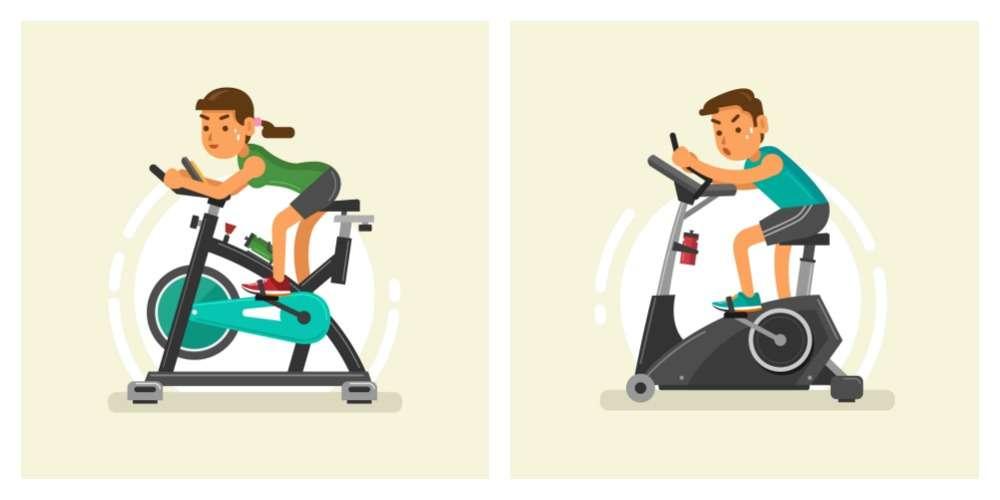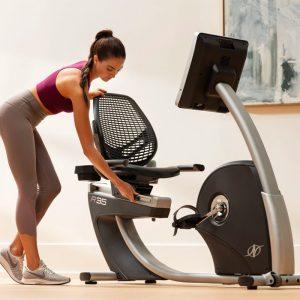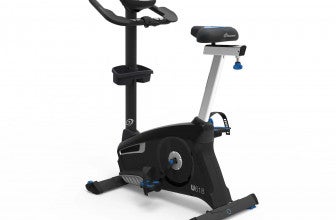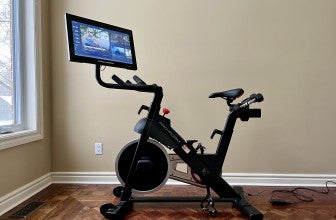As you get set to begin your cycling workout program, one question you may find yourself asking is stationary bike vs. spin bike. Which one should you do? You’ve seen both in the gym and have always wondered what the key differences were and which would be the better bet for your overall progress.
We’re here today to outline the pros and cons of each bike and hopefully help you better understand which is going to be the superior option for you.
| Stationary Bike | Spin Bike | |
| Primary Use | Regular cycling | Spinning |
| Ease Of Use | Good | Good |
| Injury Risk | Low | Moderate |
| Calorie Burn | Moderate | High |
| Muscles Worked | Quads, glutes, hamstrings, calves | Quads, glutes, hamstrings, calves, shoulders, back, biceps, triceps, core |
| Progression Model | Increase speed or resistance | Increase speed, resistance, or stand |
| Console | Yes | No |
Now that you have a brief overview of the two types of machines, let’s look at the pros and cons a little more closely.
Primary Use
First let’s consider the primary use of the different bikes. Stationary bikes are typically used in a general health and fitness program and tend to be good for anyone who is hoping to simply improve their cardiovascular fitness level, build muscle strength, and see better results from their weight loss efforts.
Spin bikes on the other hand, are used for spinning group fitness classes and are more traditionally used by those who actually participate in cycling as a sport. They more closely mimic the body position that regular bikes do as the handle bar position is lower so you are more hunched over while using them.
Therefore, there is greater transfer over benefits if you are actually a cyclist and simply looking to train indoors.
This said, that does not mean you can’t do spinning as just part of your general health and fitness program. This is completely acceptable and there are still many benefits to doing so.
Ease Of Use

If you’ve ever ridden a regular bike before, as a kid or as an adult, you’ll likely have no trouble transitioning. The upright bike may feel slightly different than a traditional bike but the difference is not noticeable enough to cause any issues with completing the workout.
Also, spin bikes tend to be a bit larger and heavier due to the flywheel. They’re a bit harder to move about the room, which does make them better for that which they’re designed, but a bit more cumbersome nonetheless. Meanwhile, the stationary bikes tend to be a bit lighter, smaller, more compact, and perhaps even foldable.
Comfort is also a consideration here as the spin bikes are meant for shorter, speedier exercise sessions and their seats are also a bit harder. The stationary bikes tend to have comfier seats and designed for longer sessions.
Injury Risk
If you are considering injury risk, when we look at the machine set up itself, the spin bike actually has a lower injury risk than the typical upright bike. This is because the flywheel is much easier, so it helps keep the bike in constant motion, therefore is less impactful on the joints.
This said, those who do spinning quite intensely are typically spinning faster and may also be standing on the bike, therefore this greater range of movement patterns can increase your injury risk.
Standing and spinning is always going to put you at a higher injury risk than sitting and spinning, so that’s something that must be taken into account.
If you simply use the spinning bike to sit and spin, then your injury risk on this will be very low. What you may find you suffer from the most is back pain from being hunched over more on this type of cycle.
Progression Model
The progression model is quite similar for both types of bikes. On each, you can increase the resistance level higher, making the exercise harder to complete. This forces the muscles to work harder and thus helps you build strength and fitness. The harder your muscles have to work against resistance, the more your heart will also be working, so this also helps elevate your cardiovascular fitness level as well.
Both bikes also allow you to go faster, so if speed is your primary goal, you can easily do that on either machine.
Where they differ is as noted above, the spin bike allows you to stand and cycle. The regular upright bike does not (well you can, but it will be very awkward to do), so you’ll want to ensure that you decide whether that’s something you want to incorporate in your workout program or not.
Being able to stand does open the doors for more exercise variation so if you are someone who is easily bored during your workout sessions, this is definitely a consideration to have.
Muscles Worked

When you stand however, you will now be putting more stress on those lower body muscles, especially the calves, while also working the shoulders, arms, back, and core to a much larger degree.
As soon as you begin standing, it turns into a more complete full body workout, so this will be a great benefit to take into account and consider.
If you aren’t doing many other exercises, investing in a spin bike may be your superior choice.
Calorie Burn
The calorie burn is another factor to consider in the debate of the stationary bike vs. the spin bike. Generally speaking, you’ll tend to burn more calories on a spin bike because you’ll incorporate more muscles into the exercise (if you stand up) and because it takes more energy to keep that flywheel going.
The flywheels in the spin bike are heavier than the regular bike, so you’ll burn more energy completing each rep that you perform.
There isn’t going to be a tremendous difference in calorie burns in a seated position however, so if you never plan to stand, you’ll probably just want to go with whatever bike is most comfortable for you if this is a primary deciding factor.
Console
Finally, also take note that the spin bike doesn’t typically come with a console that will give you all the stats of your workout like how far you’ve travelled, how many calories you’ve burned, and with programmable options as well.
So if that’s important to you, you’ll want to go with the upright bike instead.
Conclusion
Deciding between the stationary bike vs. the spin bike can be a challenge but if you look at how you plan to use it and actually try a couple machines to figure out which you are most comfortable on, it should be a relatively easy decision for you.
Photo credit: VGstockstudio/Shutterstock; konggraphic/Shutterstock; Supavadee butradee/Shutterstock





